An Analysis of Teaching, Learning, and Assessment in Education
VerifiedAdded on 2023/06/10
|21
|5926
|326
Report
AI Summary
This report delves into the critical aspects of teaching, learning, and assessment within the education and training sector, focusing on the specialism of 'Business Management.' It analyzes the roles and responsibilities of educators, along with the relevant legislations and codes of practice. The report examines the relationships and boundaries between teaching roles and other professional roles, describing referral points for meeting learners' needs and the use of initial and diagnostic assessments in setting learning goals. It emphasizes the importance of understanding and meeting individual learner requirements, adapting teaching plans, promoting appropriate behavior and equality, and utilizing various assessment types. Furthermore, the report evaluates the effectiveness of teaching approaches, communication methods, and resources, and reviews personal practices in planning, delivering, and assessing inclusive teaching and learning, while also identifying areas for improvement. This document is available on Desklib, a platform offering AI-based study tools and a wide range of academic resources for students.
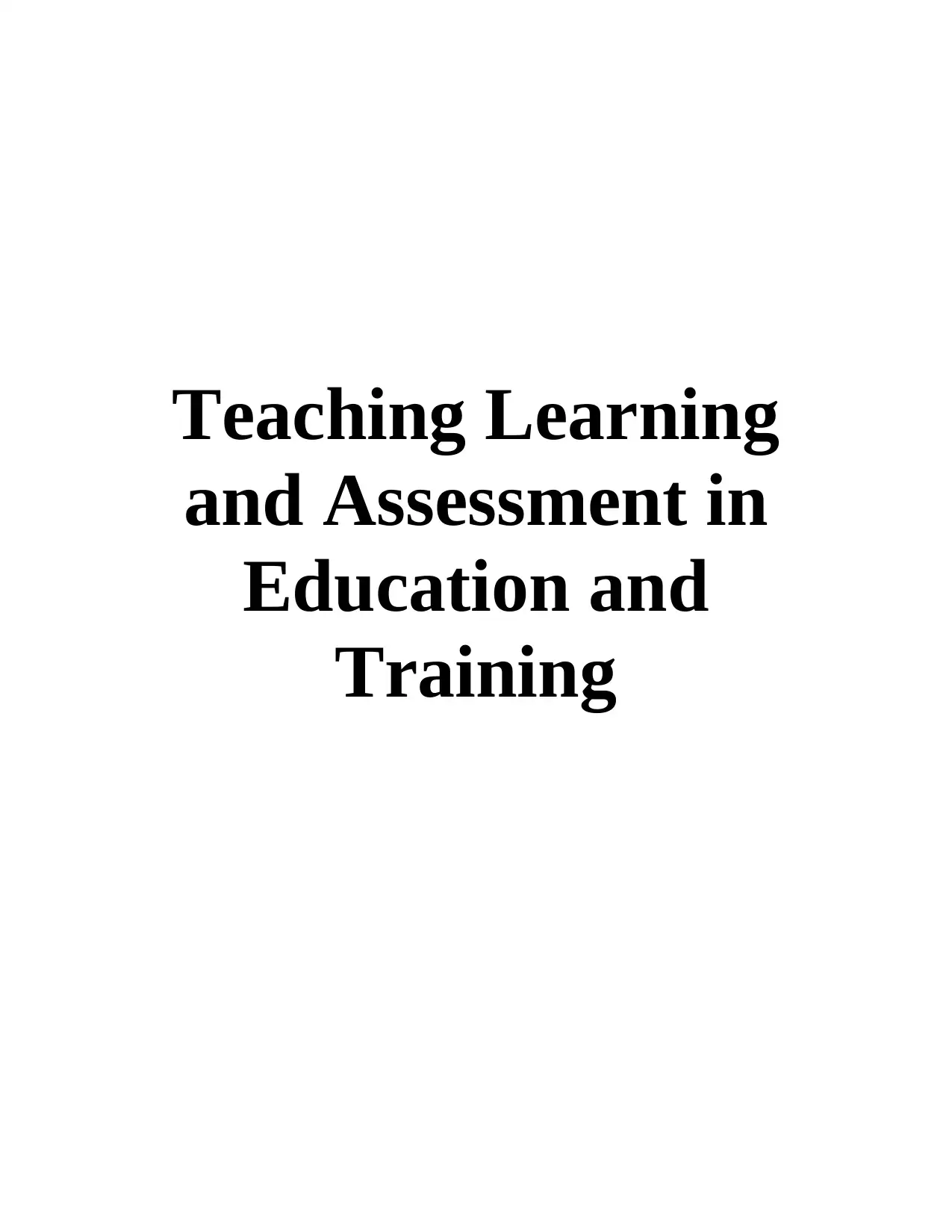
Teaching Learning
and Assessment in
Education and
Training
and Assessment in
Education and
Training
Paraphrase This Document
Need a fresh take? Get an instant paraphrase of this document with our AI Paraphraser
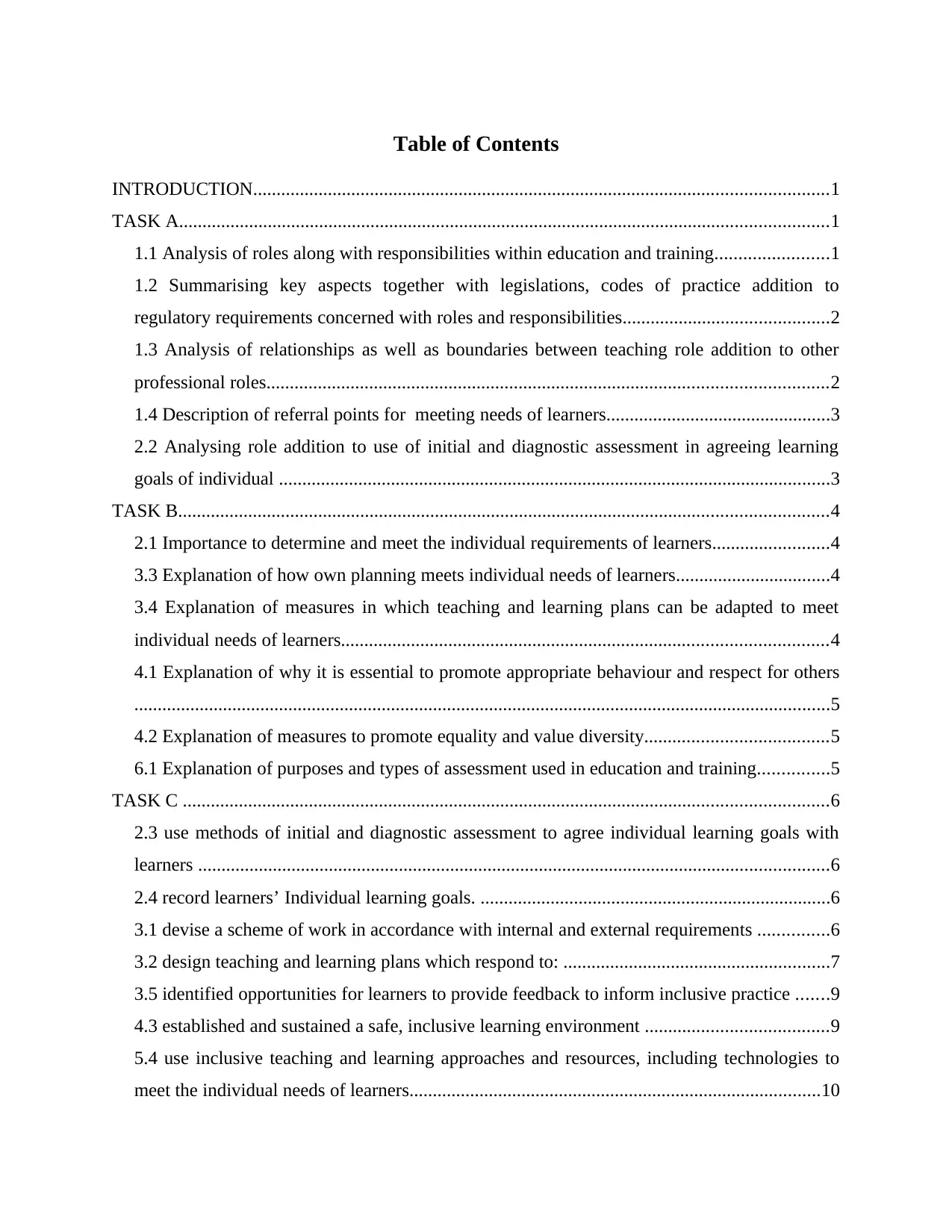
Table of Contents
INTRODUCTION...........................................................................................................................1
TASK A...........................................................................................................................................1
1.1 Analysis of roles along with responsibilities within education and training........................1
1.2 Summarising key aspects together with legislations, codes of practice addition to
regulatory requirements concerned with roles and responsibilities............................................2
1.3 Analysis of relationships as well as boundaries between teaching role addition to other
professional roles........................................................................................................................2
1.4 Description of referral points for meeting needs of learners................................................3
2.2 Analysing role addition to use of initial and diagnostic assessment in agreeing learning
goals of individual ......................................................................................................................3
TASK B...........................................................................................................................................4
2.1 Importance to determine and meet the individual requirements of learners.........................4
3.3 Explanation of how own planning meets individual needs of learners.................................4
3.4 Explanation of measures in which teaching and learning plans can be adapted to meet
individual needs of learners........................................................................................................4
4.1 Explanation of why it is essential to promote appropriate behaviour and respect for others
.....................................................................................................................................................5
4.2 Explanation of measures to promote equality and value diversity.......................................5
6.1 Explanation of purposes and types of assessment used in education and training...............5
TASK C ..........................................................................................................................................6
2.3 use methods of initial and diagnostic assessment to agree individual learning goals with
learners .......................................................................................................................................6
2.4 record learners’ Individual learning goals. ...........................................................................6
3.1 devise a scheme of work in accordance with internal and external requirements ...............6
3.2 design teaching and learning plans which respond to: .........................................................7
3.5 identified opportunities for learners to provide feedback to inform inclusive practice .......9
4.3 established and sustained a safe, inclusive learning environment .......................................9
5.4 use inclusive teaching and learning approaches and resources, including technologies to
meet the individual needs of learners........................................................................................10
INTRODUCTION...........................................................................................................................1
TASK A...........................................................................................................................................1
1.1 Analysis of roles along with responsibilities within education and training........................1
1.2 Summarising key aspects together with legislations, codes of practice addition to
regulatory requirements concerned with roles and responsibilities............................................2
1.3 Analysis of relationships as well as boundaries between teaching role addition to other
professional roles........................................................................................................................2
1.4 Description of referral points for meeting needs of learners................................................3
2.2 Analysing role addition to use of initial and diagnostic assessment in agreeing learning
goals of individual ......................................................................................................................3
TASK B...........................................................................................................................................4
2.1 Importance to determine and meet the individual requirements of learners.........................4
3.3 Explanation of how own planning meets individual needs of learners.................................4
3.4 Explanation of measures in which teaching and learning plans can be adapted to meet
individual needs of learners........................................................................................................4
4.1 Explanation of why it is essential to promote appropriate behaviour and respect for others
.....................................................................................................................................................5
4.2 Explanation of measures to promote equality and value diversity.......................................5
6.1 Explanation of purposes and types of assessment used in education and training...............5
TASK C ..........................................................................................................................................6
2.3 use methods of initial and diagnostic assessment to agree individual learning goals with
learners .......................................................................................................................................6
2.4 record learners’ Individual learning goals. ...........................................................................6
3.1 devise a scheme of work in accordance with internal and external requirements ...............6
3.2 design teaching and learning plans which respond to: .........................................................7
3.5 identified opportunities for learners to provide feedback to inform inclusive practice .......9
4.3 established and sustained a safe, inclusive learning environment .......................................9
5.4 use inclusive teaching and learning approaches and resources, including technologies to
meet the individual needs of learners........................................................................................10
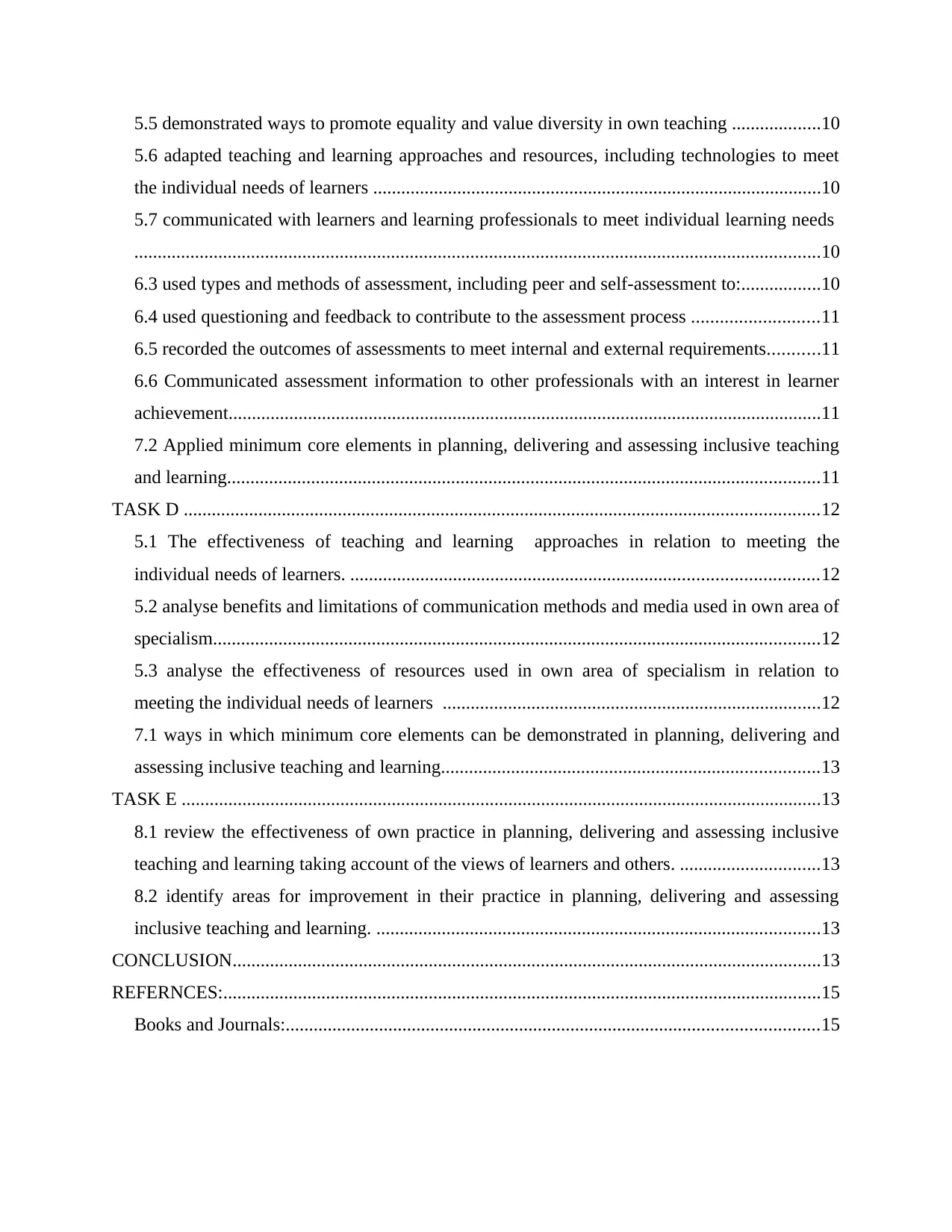
5.5 demonstrated ways to promote equality and value diversity in own teaching ...................10
5.6 adapted teaching and learning approaches and resources, including technologies to meet
the individual needs of learners ................................................................................................10
5.7 communicated with learners and learning professionals to meet individual learning needs
...................................................................................................................................................10
6.3 used types and methods of assessment, including peer and self-assessment to:.................10
6.4 used questioning and feedback to contribute to the assessment process ...........................11
6.5 recorded the outcomes of assessments to meet internal and external requirements...........11
6.6 Communicated assessment information to other professionals with an interest in learner
achievement...............................................................................................................................11
7.2 Applied minimum core elements in planning, delivering and assessing inclusive teaching
and learning...............................................................................................................................11
TASK D ........................................................................................................................................12
5.1 The effectiveness of teaching and learning approaches in relation to meeting the
individual needs of learners. ....................................................................................................12
5.2 analyse benefits and limitations of communication methods and media used in own area of
specialism..................................................................................................................................12
5.3 analyse the effectiveness of resources used in own area of specialism in relation to
meeting the individual needs of learners .................................................................................12
7.1 ways in which minimum core elements can be demonstrated in planning, delivering and
assessing inclusive teaching and learning.................................................................................13
TASK E .........................................................................................................................................13
8.1 review the effectiveness of own practice in planning, delivering and assessing inclusive
teaching and learning taking account of the views of learners and others. ..............................13
8.2 identify areas for improvement in their practice in planning, delivering and assessing
inclusive teaching and learning. ...............................................................................................13
CONCLUSION..............................................................................................................................13
REFERNCES:................................................................................................................................15
Books and Journals:..................................................................................................................15
5.6 adapted teaching and learning approaches and resources, including technologies to meet
the individual needs of learners ................................................................................................10
5.7 communicated with learners and learning professionals to meet individual learning needs
...................................................................................................................................................10
6.3 used types and methods of assessment, including peer and self-assessment to:.................10
6.4 used questioning and feedback to contribute to the assessment process ...........................11
6.5 recorded the outcomes of assessments to meet internal and external requirements...........11
6.6 Communicated assessment information to other professionals with an interest in learner
achievement...............................................................................................................................11
7.2 Applied minimum core elements in planning, delivering and assessing inclusive teaching
and learning...............................................................................................................................11
TASK D ........................................................................................................................................12
5.1 The effectiveness of teaching and learning approaches in relation to meeting the
individual needs of learners. ....................................................................................................12
5.2 analyse benefits and limitations of communication methods and media used in own area of
specialism..................................................................................................................................12
5.3 analyse the effectiveness of resources used in own area of specialism in relation to
meeting the individual needs of learners .................................................................................12
7.1 ways in which minimum core elements can be demonstrated in planning, delivering and
assessing inclusive teaching and learning.................................................................................13
TASK E .........................................................................................................................................13
8.1 review the effectiveness of own practice in planning, delivering and assessing inclusive
teaching and learning taking account of the views of learners and others. ..............................13
8.2 identify areas for improvement in their practice in planning, delivering and assessing
inclusive teaching and learning. ...............................................................................................13
CONCLUSION..............................................................................................................................13
REFERNCES:................................................................................................................................15
Books and Journals:..................................................................................................................15
⊘ This is a preview!⊘
Do you want full access?
Subscribe today to unlock all pages.

Trusted by 1+ million students worldwide

Paraphrase This Document
Need a fresh take? Get an instant paraphrase of this document with our AI Paraphraser
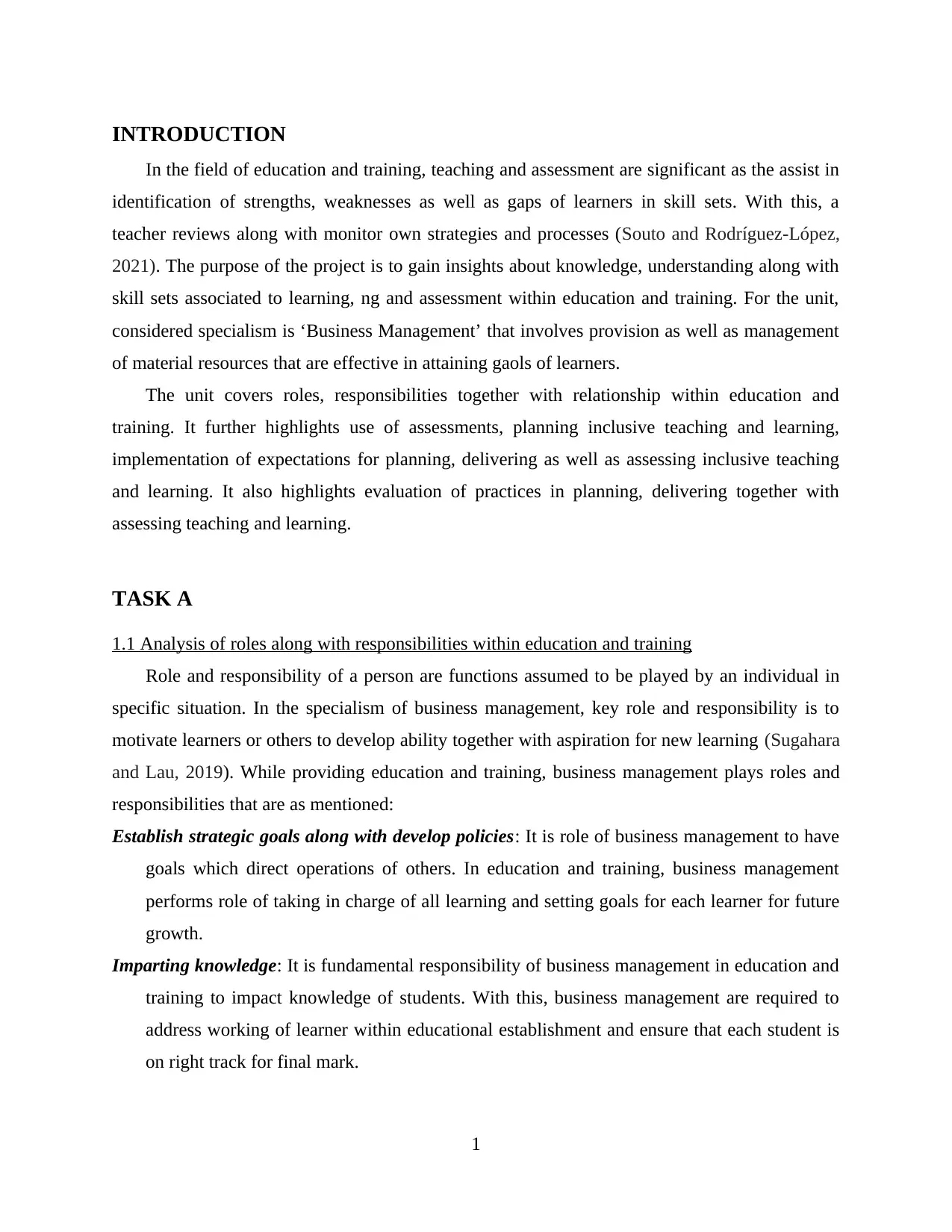
INTRODUCTION
In the field of education and training, teaching and assessment are significant as the assist in
identification of strengths, weaknesses as well as gaps of learners in skill sets. With this, a
teacher reviews along with monitor own strategies and processes (Souto and Rodríguez-López,
2021). The purpose of the project is to gain insights about knowledge, understanding along with
skill sets associated to learning, ng and assessment within education and training. For the unit,
considered specialism is ‘Business Management’ that involves provision as well as management
of material resources that are effective in attaining gaols of learners.
The unit covers roles, responsibilities together with relationship within education and
training. It further highlights use of assessments, planning inclusive teaching and learning,
implementation of expectations for planning, delivering as well as assessing inclusive teaching
and learning. It also highlights evaluation of practices in planning, delivering together with
assessing teaching and learning.
TASK A
1.1 Analysis of roles along with responsibilities within education and training
Role and responsibility of a person are functions assumed to be played by an individual in
specific situation. In the specialism of business management, key role and responsibility is to
motivate learners or others to develop ability together with aspiration for new learning (Sugahara
and Lau, 2019). While providing education and training, business management plays roles and
responsibilities that are as mentioned:
Establish strategic goals along with develop policies: It is role of business management to have
goals which direct operations of others. In education and training, business management
performs role of taking in charge of all learning and setting goals for each learner for future
growth.
Imparting knowledge: It is fundamental responsibility of business management in education and
training to impact knowledge of students. With this, business management are required to
address working of learner within educational establishment and ensure that each student is
on right track for final mark.
1
In the field of education and training, teaching and assessment are significant as the assist in
identification of strengths, weaknesses as well as gaps of learners in skill sets. With this, a
teacher reviews along with monitor own strategies and processes (Souto and Rodríguez-López,
2021). The purpose of the project is to gain insights about knowledge, understanding along with
skill sets associated to learning, ng and assessment within education and training. For the unit,
considered specialism is ‘Business Management’ that involves provision as well as management
of material resources that are effective in attaining gaols of learners.
The unit covers roles, responsibilities together with relationship within education and
training. It further highlights use of assessments, planning inclusive teaching and learning,
implementation of expectations for planning, delivering as well as assessing inclusive teaching
and learning. It also highlights evaluation of practices in planning, delivering together with
assessing teaching and learning.
TASK A
1.1 Analysis of roles along with responsibilities within education and training
Role and responsibility of a person are functions assumed to be played by an individual in
specific situation. In the specialism of business management, key role and responsibility is to
motivate learners or others to develop ability together with aspiration for new learning (Sugahara
and Lau, 2019). While providing education and training, business management plays roles and
responsibilities that are as mentioned:
Establish strategic goals along with develop policies: It is role of business management to have
goals which direct operations of others. In education and training, business management
performs role of taking in charge of all learning and setting goals for each learner for future
growth.
Imparting knowledge: It is fundamental responsibility of business management in education and
training to impact knowledge of students. With this, business management are required to
address working of learner within educational establishment and ensure that each student is
on right track for final mark.
1
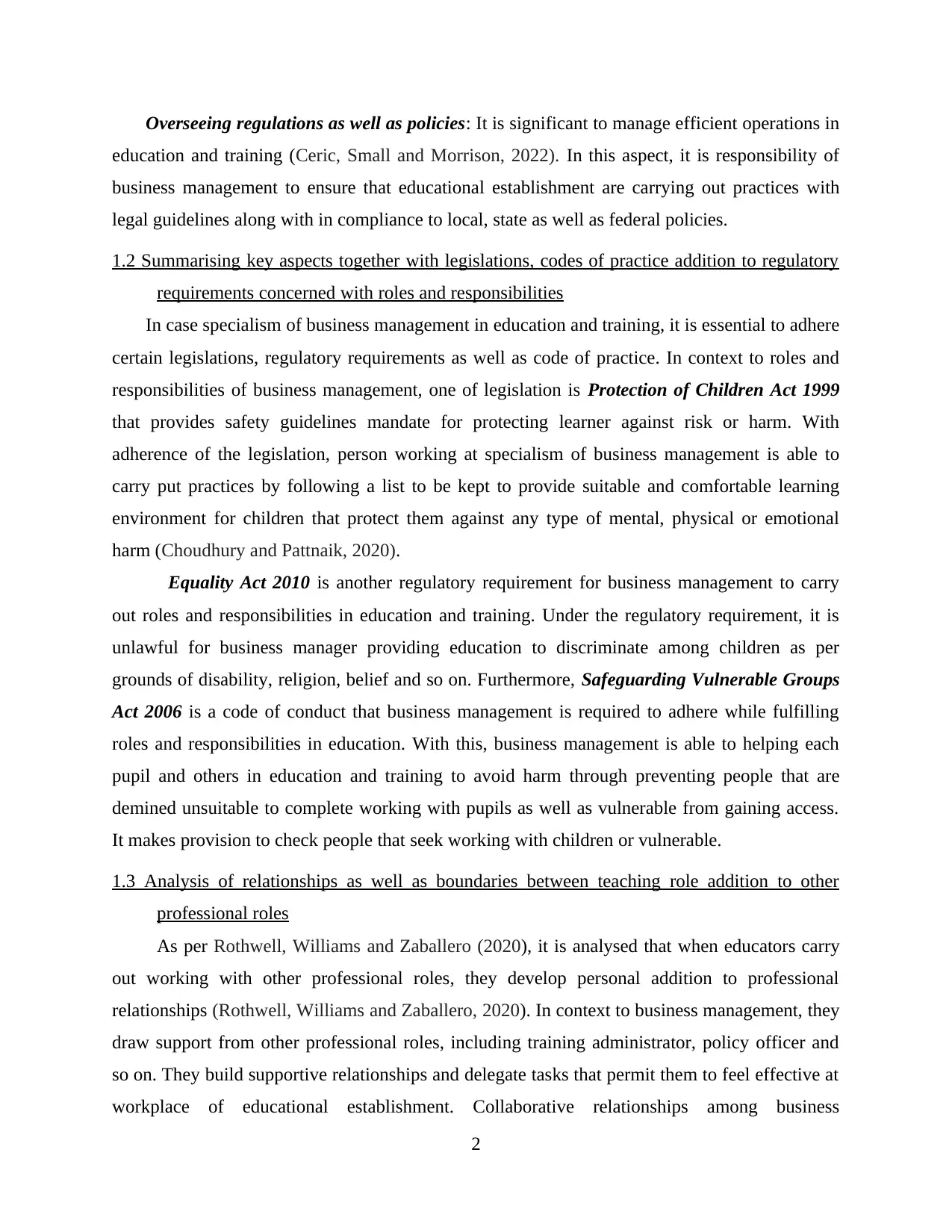
Overseeing regulations as well as policies: It is significant to manage efficient operations in
education and training (Ceric, Small and Morrison, 2022). In this aspect, it is responsibility of
business management to ensure that educational establishment are carrying out practices with
legal guidelines along with in compliance to local, state as well as federal policies.
1.2 Summarising key aspects together with legislations, codes of practice addition to regulatory
requirements concerned with roles and responsibilities
In case specialism of business management in education and training, it is essential to adhere
certain legislations, regulatory requirements as well as code of practice. In context to roles and
responsibilities of business management, one of legislation is Protection of Children Act 1999
that provides safety guidelines mandate for protecting learner against risk or harm. With
adherence of the legislation, person working at specialism of business management is able to
carry put practices by following a list to be kept to provide suitable and comfortable learning
environment for children that protect them against any type of mental, physical or emotional
harm (Choudhury and Pattnaik, 2020).
Equality Act 2010 is another regulatory requirement for business management to carry
out roles and responsibilities in education and training. Under the regulatory requirement, it is
unlawful for business manager providing education to discriminate among children as per
grounds of disability, religion, belief and so on. Furthermore, Safeguarding Vulnerable Groups
Act 2006 is a code of conduct that business management is required to adhere while fulfilling
roles and responsibilities in education. With this, business management is able to helping each
pupil and others in education and training to avoid harm through preventing people that are
demined unsuitable to complete working with pupils as well as vulnerable from gaining access.
It makes provision to check people that seek working with children or vulnerable.
1.3 Analysis of relationships as well as boundaries between teaching role addition to other
professional roles
As per Rothwell, Williams and Zaballero (2020), it is analysed that when educators carry
out working with other professional roles, they develop personal addition to professional
relationships (Rothwell, Williams and Zaballero, 2020). In context to business management, they
draw support from other professional roles, including training administrator, policy officer and
so on. They build supportive relationships and delegate tasks that permit them to feel effective at
workplace of educational establishment. Collaborative relationships among business
2
education and training (Ceric, Small and Morrison, 2022). In this aspect, it is responsibility of
business management to ensure that educational establishment are carrying out practices with
legal guidelines along with in compliance to local, state as well as federal policies.
1.2 Summarising key aspects together with legislations, codes of practice addition to regulatory
requirements concerned with roles and responsibilities
In case specialism of business management in education and training, it is essential to adhere
certain legislations, regulatory requirements as well as code of practice. In context to roles and
responsibilities of business management, one of legislation is Protection of Children Act 1999
that provides safety guidelines mandate for protecting learner against risk or harm. With
adherence of the legislation, person working at specialism of business management is able to
carry put practices by following a list to be kept to provide suitable and comfortable learning
environment for children that protect them against any type of mental, physical or emotional
harm (Choudhury and Pattnaik, 2020).
Equality Act 2010 is another regulatory requirement for business management to carry
out roles and responsibilities in education and training. Under the regulatory requirement, it is
unlawful for business manager providing education to discriminate among children as per
grounds of disability, religion, belief and so on. Furthermore, Safeguarding Vulnerable Groups
Act 2006 is a code of conduct that business management is required to adhere while fulfilling
roles and responsibilities in education. With this, business management is able to helping each
pupil and others in education and training to avoid harm through preventing people that are
demined unsuitable to complete working with pupils as well as vulnerable from gaining access.
It makes provision to check people that seek working with children or vulnerable.
1.3 Analysis of relationships as well as boundaries between teaching role addition to other
professional roles
As per Rothwell, Williams and Zaballero (2020), it is analysed that when educators carry
out working with other professional roles, they develop personal addition to professional
relationships (Rothwell, Williams and Zaballero, 2020). In context to business management, they
draw support from other professional roles, including training administrator, policy officer and
so on. They build supportive relationships and delegate tasks that permit them to feel effective at
workplace of educational establishment. Collaborative relationships among business
2
⊘ This is a preview!⊘
Do you want full access?
Subscribe today to unlock all pages.

Trusted by 1+ million students worldwide
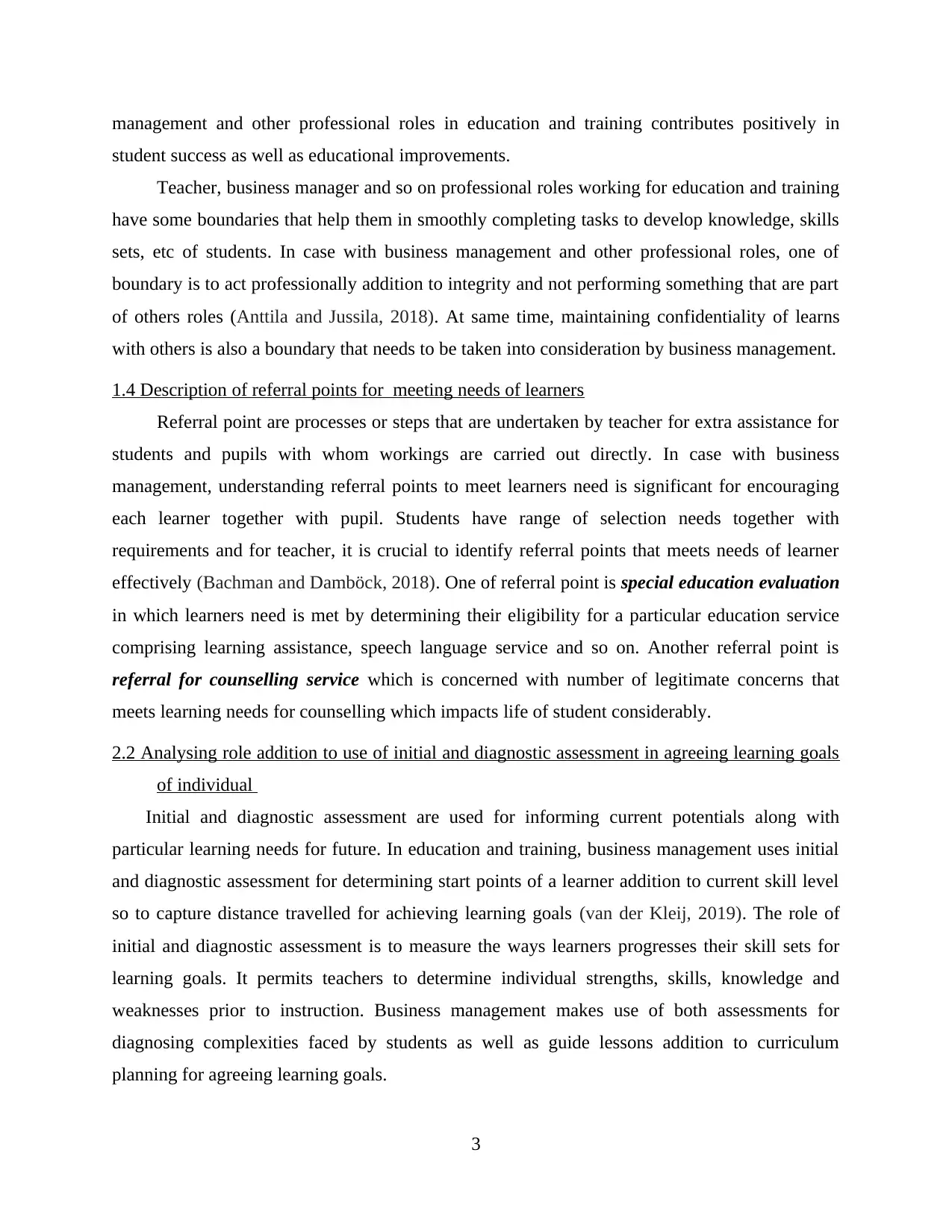
management and other professional roles in education and training contributes positively in
student success as well as educational improvements.
Teacher, business manager and so on professional roles working for education and training
have some boundaries that help them in smoothly completing tasks to develop knowledge, skills
sets, etc of students. In case with business management and other professional roles, one of
boundary is to act professionally addition to integrity and not performing something that are part
of others roles (Anttila and Jussila, 2018). At same time, maintaining confidentiality of learns
with others is also a boundary that needs to be taken into consideration by business management.
1.4 Description of referral points for meeting needs of learners
Referral point are processes or steps that are undertaken by teacher for extra assistance for
students and pupils with whom workings are carried out directly. In case with business
management, understanding referral points to meet learners need is significant for encouraging
each learner together with pupil. Students have range of selection needs together with
requirements and for teacher, it is crucial to identify referral points that meets needs of learner
effectively (Bachman and Damböck, 2018). One of referral point is special education evaluation
in which learners need is met by determining their eligibility for a particular education service
comprising learning assistance, speech language service and so on. Another referral point is
referral for counselling service which is concerned with number of legitimate concerns that
meets learning needs for counselling which impacts life of student considerably.
2.2 Analysing role addition to use of initial and diagnostic assessment in agreeing learning goals
of individual
Initial and diagnostic assessment are used for informing current potentials along with
particular learning needs for future. In education and training, business management uses initial
and diagnostic assessment for determining start points of a learner addition to current skill level
so to capture distance travelled for achieving learning goals (van der Kleij, 2019). The role of
initial and diagnostic assessment is to measure the ways learners progresses their skill sets for
learning goals. It permits teachers to determine individual strengths, skills, knowledge and
weaknesses prior to instruction. Business management makes use of both assessments for
diagnosing complexities faced by students as well as guide lessons addition to curriculum
planning for agreeing learning goals.
3
student success as well as educational improvements.
Teacher, business manager and so on professional roles working for education and training
have some boundaries that help them in smoothly completing tasks to develop knowledge, skills
sets, etc of students. In case with business management and other professional roles, one of
boundary is to act professionally addition to integrity and not performing something that are part
of others roles (Anttila and Jussila, 2018). At same time, maintaining confidentiality of learns
with others is also a boundary that needs to be taken into consideration by business management.
1.4 Description of referral points for meeting needs of learners
Referral point are processes or steps that are undertaken by teacher for extra assistance for
students and pupils with whom workings are carried out directly. In case with business
management, understanding referral points to meet learners need is significant for encouraging
each learner together with pupil. Students have range of selection needs together with
requirements and for teacher, it is crucial to identify referral points that meets needs of learner
effectively (Bachman and Damböck, 2018). One of referral point is special education evaluation
in which learners need is met by determining their eligibility for a particular education service
comprising learning assistance, speech language service and so on. Another referral point is
referral for counselling service which is concerned with number of legitimate concerns that
meets learning needs for counselling which impacts life of student considerably.
2.2 Analysing role addition to use of initial and diagnostic assessment in agreeing learning goals
of individual
Initial and diagnostic assessment are used for informing current potentials along with
particular learning needs for future. In education and training, business management uses initial
and diagnostic assessment for determining start points of a learner addition to current skill level
so to capture distance travelled for achieving learning goals (van der Kleij, 2019). The role of
initial and diagnostic assessment is to measure the ways learners progresses their skill sets for
learning goals. It permits teachers to determine individual strengths, skills, knowledge and
weaknesses prior to instruction. Business management makes use of both assessments for
diagnosing complexities faced by students as well as guide lessons addition to curriculum
planning for agreeing learning goals.
3
Paraphrase This Document
Need a fresh take? Get an instant paraphrase of this document with our AI Paraphraser
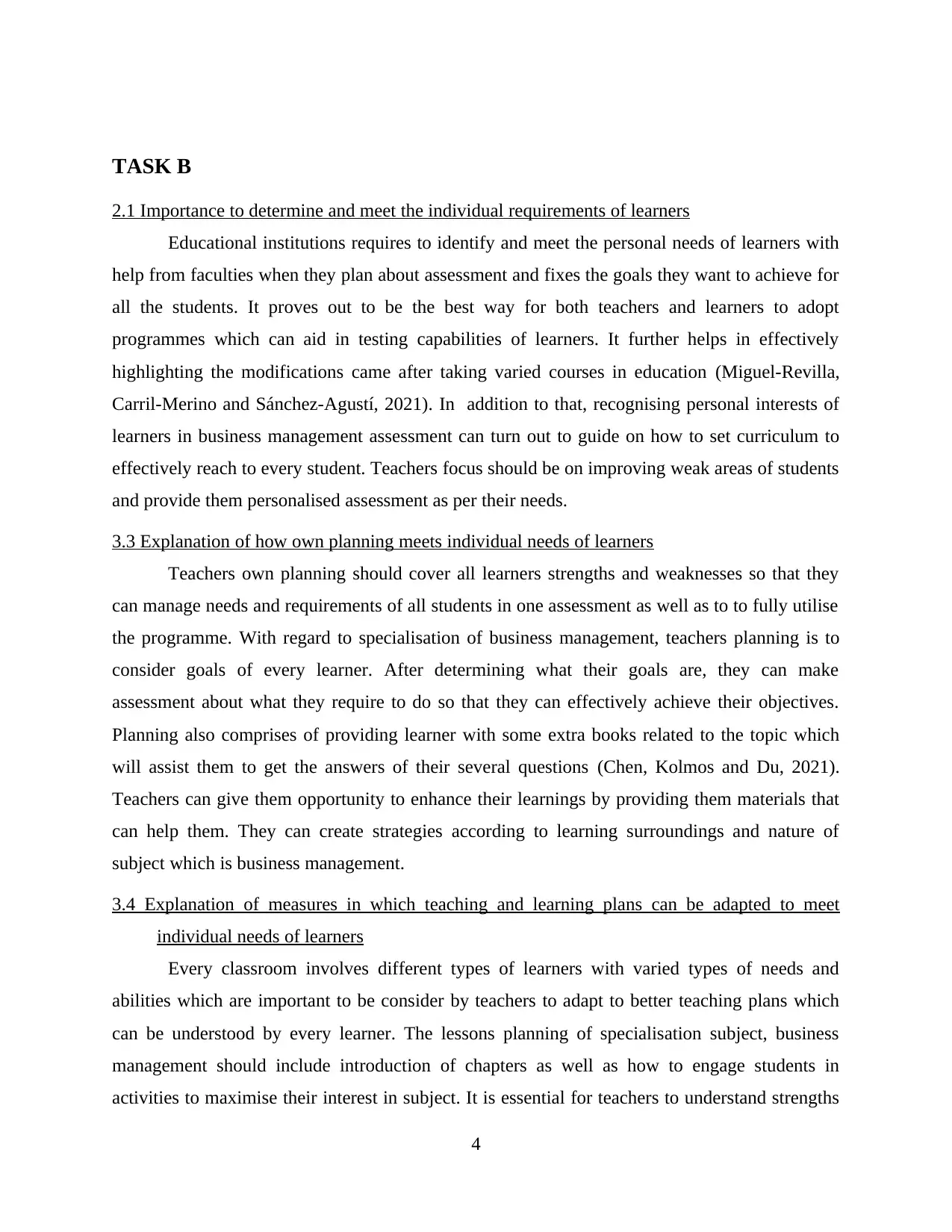
TASK B
2.1 Importance to determine and meet the individual requirements of learners
Educational institutions requires to identify and meet the personal needs of learners with
help from faculties when they plan about assessment and fixes the goals they want to achieve for
all the students. It proves out to be the best way for both teachers and learners to adopt
programmes which can aid in testing capabilities of learners. It further helps in effectively
highlighting the modifications came after taking varied courses in education (Miguel-Revilla,
Carril-Merino and Sánchez-Agustí, 2021). In addition to that, recognising personal interests of
learners in business management assessment can turn out to guide on how to set curriculum to
effectively reach to every student. Teachers focus should be on improving weak areas of students
and provide them personalised assessment as per their needs.
3.3 Explanation of how own planning meets individual needs of learners
Teachers own planning should cover all learners strengths and weaknesses so that they
can manage needs and requirements of all students in one assessment as well as to to fully utilise
the programme. With regard to specialisation of business management, teachers planning is to
consider goals of every learner. After determining what their goals are, they can make
assessment about what they require to do so that they can effectively achieve their objectives.
Planning also comprises of providing learner with some extra books related to the topic which
will assist them to get the answers of their several questions (Chen, Kolmos and Du, 2021).
Teachers can give them opportunity to enhance their learnings by providing them materials that
can help them. They can create strategies according to learning surroundings and nature of
subject which is business management.
3.4 Explanation of measures in which teaching and learning plans can be adapted to meet
individual needs of learners
Every classroom involves different types of learners with varied types of needs and
abilities which are important to be consider by teachers to adapt to better teaching plans which
can be understood by every learner. The lessons planning of specialisation subject, business
management should include introduction of chapters as well as how to engage students in
activities to maximise their interest in subject. It is essential for teachers to understand strengths
4
2.1 Importance to determine and meet the individual requirements of learners
Educational institutions requires to identify and meet the personal needs of learners with
help from faculties when they plan about assessment and fixes the goals they want to achieve for
all the students. It proves out to be the best way for both teachers and learners to adopt
programmes which can aid in testing capabilities of learners. It further helps in effectively
highlighting the modifications came after taking varied courses in education (Miguel-Revilla,
Carril-Merino and Sánchez-Agustí, 2021). In addition to that, recognising personal interests of
learners in business management assessment can turn out to guide on how to set curriculum to
effectively reach to every student. Teachers focus should be on improving weak areas of students
and provide them personalised assessment as per their needs.
3.3 Explanation of how own planning meets individual needs of learners
Teachers own planning should cover all learners strengths and weaknesses so that they
can manage needs and requirements of all students in one assessment as well as to to fully utilise
the programme. With regard to specialisation of business management, teachers planning is to
consider goals of every learner. After determining what their goals are, they can make
assessment about what they require to do so that they can effectively achieve their objectives.
Planning also comprises of providing learner with some extra books related to the topic which
will assist them to get the answers of their several questions (Chen, Kolmos and Du, 2021).
Teachers can give them opportunity to enhance their learnings by providing them materials that
can help them. They can create strategies according to learning surroundings and nature of
subject which is business management.
3.4 Explanation of measures in which teaching and learning plans can be adapted to meet
individual needs of learners
Every classroom involves different types of learners with varied types of needs and
abilities which are important to be consider by teachers to adapt to better teaching plans which
can be understood by every learner. The lessons planning of specialisation subject, business
management should include introduction of chapters as well as how to engage students in
activities to maximise their interest in subject. It is essential for teachers to understand strengths
4
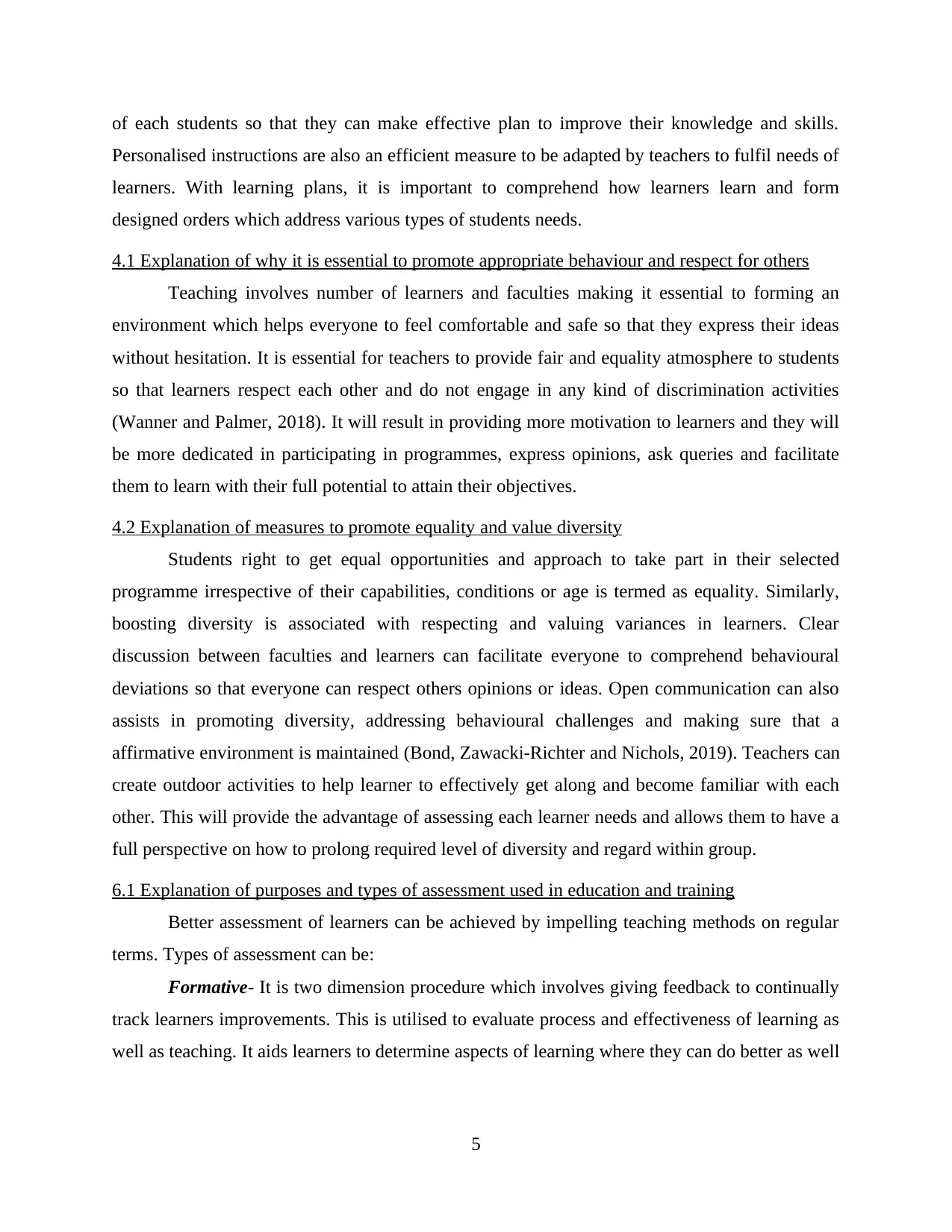
of each students so that they can make effective plan to improve their knowledge and skills.
Personalised instructions are also an efficient measure to be adapted by teachers to fulfil needs of
learners. With learning plans, it is important to comprehend how learners learn and form
designed orders which address various types of students needs.
4.1 Explanation of why it is essential to promote appropriate behaviour and respect for others
Teaching involves number of learners and faculties making it essential to forming an
environment which helps everyone to feel comfortable and safe so that they express their ideas
without hesitation. It is essential for teachers to provide fair and equality atmosphere to students
so that learners respect each other and do not engage in any kind of discrimination activities
(Wanner and Palmer, 2018). It will result in providing more motivation to learners and they will
be more dedicated in participating in programmes, express opinions, ask queries and facilitate
them to learn with their full potential to attain their objectives.
4.2 Explanation of measures to promote equality and value diversity
Students right to get equal opportunities and approach to take part in their selected
programme irrespective of their capabilities, conditions or age is termed as equality. Similarly,
boosting diversity is associated with respecting and valuing variances in learners. Clear
discussion between faculties and learners can facilitate everyone to comprehend behavioural
deviations so that everyone can respect others opinions or ideas. Open communication can also
assists in promoting diversity, addressing behavioural challenges and making sure that a
affirmative environment is maintained (Bond, Zawacki‐Richter and Nichols, 2019). Teachers can
create outdoor activities to help learner to effectively get along and become familiar with each
other. This will provide the advantage of assessing each learner needs and allows them to have a
full perspective on how to prolong required level of diversity and regard within group.
6.1 Explanation of purposes and types of assessment used in education and training
Better assessment of learners can be achieved by impelling teaching methods on regular
terms. Types of assessment can be:
Formative- It is two dimension procedure which involves giving feedback to continually
track learners improvements. This is utilised to evaluate process and effectiveness of learning as
well as teaching. It aids learners to determine aspects of learning where they can do better as well
5
Personalised instructions are also an efficient measure to be adapted by teachers to fulfil needs of
learners. With learning plans, it is important to comprehend how learners learn and form
designed orders which address various types of students needs.
4.1 Explanation of why it is essential to promote appropriate behaviour and respect for others
Teaching involves number of learners and faculties making it essential to forming an
environment which helps everyone to feel comfortable and safe so that they express their ideas
without hesitation. It is essential for teachers to provide fair and equality atmosphere to students
so that learners respect each other and do not engage in any kind of discrimination activities
(Wanner and Palmer, 2018). It will result in providing more motivation to learners and they will
be more dedicated in participating in programmes, express opinions, ask queries and facilitate
them to learn with their full potential to attain their objectives.
4.2 Explanation of measures to promote equality and value diversity
Students right to get equal opportunities and approach to take part in their selected
programme irrespective of their capabilities, conditions or age is termed as equality. Similarly,
boosting diversity is associated with respecting and valuing variances in learners. Clear
discussion between faculties and learners can facilitate everyone to comprehend behavioural
deviations so that everyone can respect others opinions or ideas. Open communication can also
assists in promoting diversity, addressing behavioural challenges and making sure that a
affirmative environment is maintained (Bond, Zawacki‐Richter and Nichols, 2019). Teachers can
create outdoor activities to help learner to effectively get along and become familiar with each
other. This will provide the advantage of assessing each learner needs and allows them to have a
full perspective on how to prolong required level of diversity and regard within group.
6.1 Explanation of purposes and types of assessment used in education and training
Better assessment of learners can be achieved by impelling teaching methods on regular
terms. Types of assessment can be:
Formative- It is two dimension procedure which involves giving feedback to continually
track learners improvements. This is utilised to evaluate process and effectiveness of learning as
well as teaching. It aids learners to determine aspects of learning where they can do better as well
5
⊘ This is a preview!⊘
Do you want full access?
Subscribe today to unlock all pages.

Trusted by 1+ million students worldwide
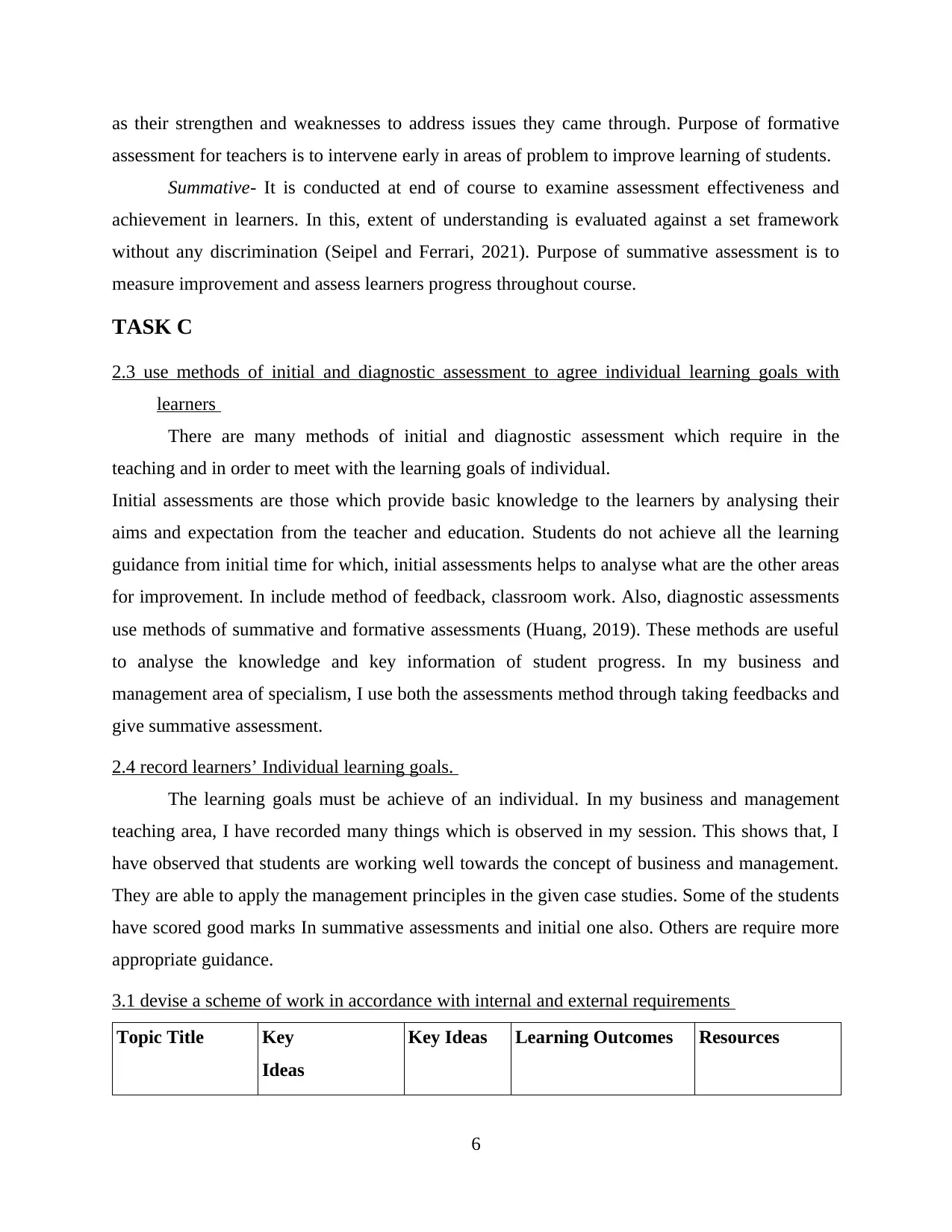
as their strengthen and weaknesses to address issues they came through. Purpose of formative
assessment for teachers is to intervene early in areas of problem to improve learning of students.
Summative- It is conducted at end of course to examine assessment effectiveness and
achievement in learners. In this, extent of understanding is evaluated against a set framework
without any discrimination (Seipel and Ferrari, 2021). Purpose of summative assessment is to
measure improvement and assess learners progress throughout course.
TASK C
2.3 use methods of initial and diagnostic assessment to agree individual learning goals with
learners
There are many methods of initial and diagnostic assessment which require in the
teaching and in order to meet with the learning goals of individual.
Initial assessments are those which provide basic knowledge to the learners by analysing their
aims and expectation from the teacher and education. Students do not achieve all the learning
guidance from initial time for which, initial assessments helps to analyse what are the other areas
for improvement. In include method of feedback, classroom work. Also, diagnostic assessments
use methods of summative and formative assessments (Huang, 2019). These methods are useful
to analyse the knowledge and key information of student progress. In my business and
management area of specialism, I use both the assessments method through taking feedbacks and
give summative assessment.
2.4 record learners’ Individual learning goals.
The learning goals must be achieve of an individual. In my business and management
teaching area, I have recorded many things which is observed in my session. This shows that, I
have observed that students are working well towards the concept of business and management.
They are able to apply the management principles in the given case studies. Some of the students
have scored good marks In summative assessments and initial one also. Others are require more
appropriate guidance.
3.1 devise a scheme of work in accordance with internal and external requirements
Topic Title Key
Ideas
Key Ideas Learning Outcomes Resources
6
assessment for teachers is to intervene early in areas of problem to improve learning of students.
Summative- It is conducted at end of course to examine assessment effectiveness and
achievement in learners. In this, extent of understanding is evaluated against a set framework
without any discrimination (Seipel and Ferrari, 2021). Purpose of summative assessment is to
measure improvement and assess learners progress throughout course.
TASK C
2.3 use methods of initial and diagnostic assessment to agree individual learning goals with
learners
There are many methods of initial and diagnostic assessment which require in the
teaching and in order to meet with the learning goals of individual.
Initial assessments are those which provide basic knowledge to the learners by analysing their
aims and expectation from the teacher and education. Students do not achieve all the learning
guidance from initial time for which, initial assessments helps to analyse what are the other areas
for improvement. In include method of feedback, classroom work. Also, diagnostic assessments
use methods of summative and formative assessments (Huang, 2019). These methods are useful
to analyse the knowledge and key information of student progress. In my business and
management area of specialism, I use both the assessments method through taking feedbacks and
give summative assessment.
2.4 record learners’ Individual learning goals.
The learning goals must be achieve of an individual. In my business and management
teaching area, I have recorded many things which is observed in my session. This shows that, I
have observed that students are working well towards the concept of business and management.
They are able to apply the management principles in the given case studies. Some of the students
have scored good marks In summative assessments and initial one also. Others are require more
appropriate guidance.
3.1 devise a scheme of work in accordance with internal and external requirements
Topic Title Key
Ideas
Key Ideas Learning Outcomes Resources
6
Paraphrase This Document
Need a fresh take? Get an instant paraphrase of this document with our AI Paraphraser
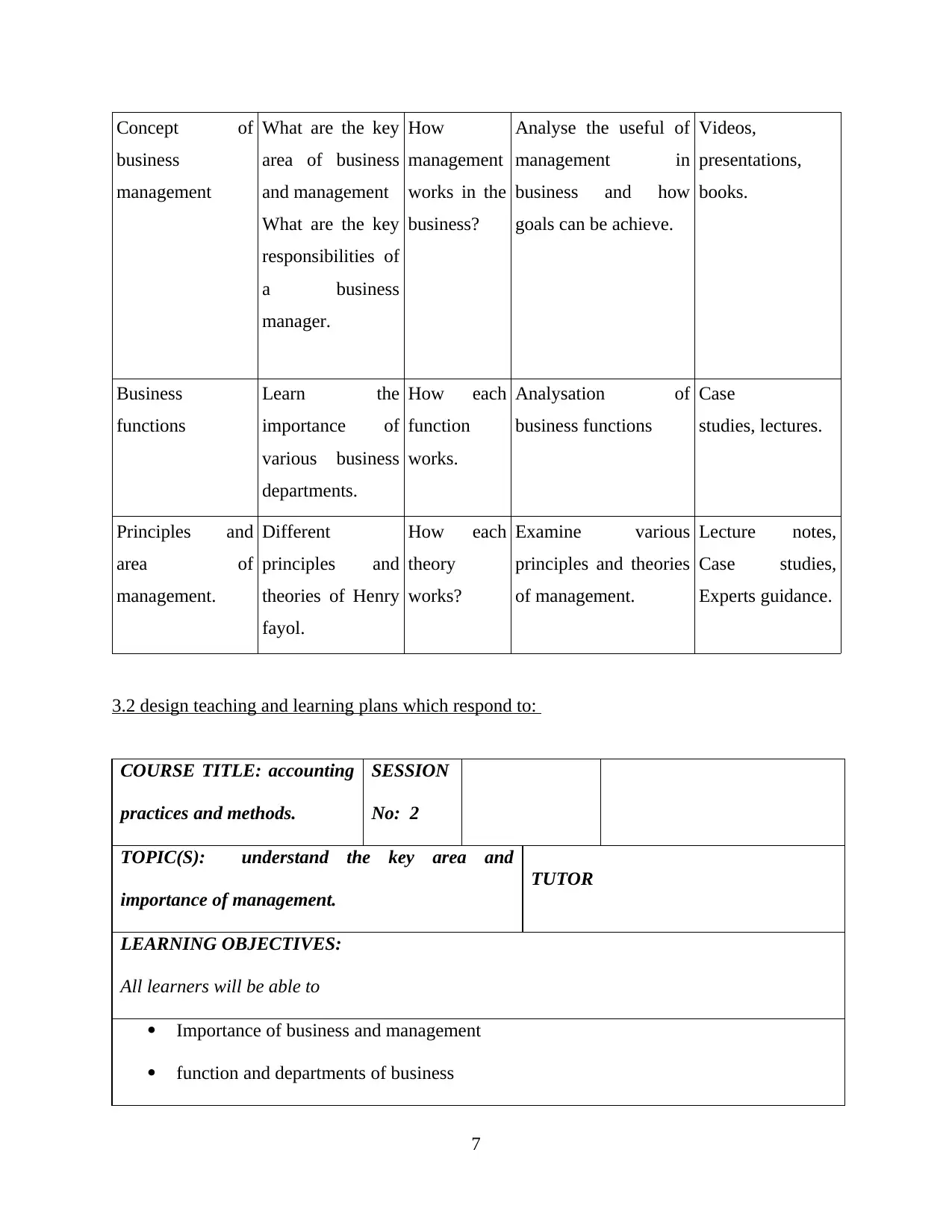
Concept of
business
management
What are the key
area of business
and management
What are the key
responsibilities of
a business
manager.
How
management
works in the
business?
Analyse the useful of
management in
business and how
goals can be achieve.
Videos,
presentations,
books.
Business
functions
Learn the
importance of
various business
departments.
How each
function
works.
Analysation of
business functions
Case
studies, lectures.
Principles and
area of
management.
Different
principles and
theories of Henry
fayol.
How each
theory
works?
Examine various
principles and theories
of management.
Lecture notes,
Case studies,
Experts guidance.
3.2 design teaching and learning plans which respond to:
COURSE TITLE: accounting
practices and methods.
SESSION
No: 2
TOPIC(S): understand the key area and
importance of management.
TUTOR
LEARNING OBJECTIVES:
All learners will be able to
Importance of business and management
function and departments of business
7
business
management
What are the key
area of business
and management
What are the key
responsibilities of
a business
manager.
How
management
works in the
business?
Analyse the useful of
management in
business and how
goals can be achieve.
Videos,
presentations,
books.
Business
functions
Learn the
importance of
various business
departments.
How each
function
works.
Analysation of
business functions
Case
studies, lectures.
Principles and
area of
management.
Different
principles and
theories of Henry
fayol.
How each
theory
works?
Examine various
principles and theories
of management.
Lecture notes,
Case studies,
Experts guidance.
3.2 design teaching and learning plans which respond to:
COURSE TITLE: accounting
practices and methods.
SESSION
No: 2
TOPIC(S): understand the key area and
importance of management.
TUTOR
LEARNING OBJECTIVES:
All learners will be able to
Importance of business and management
function and departments of business
7
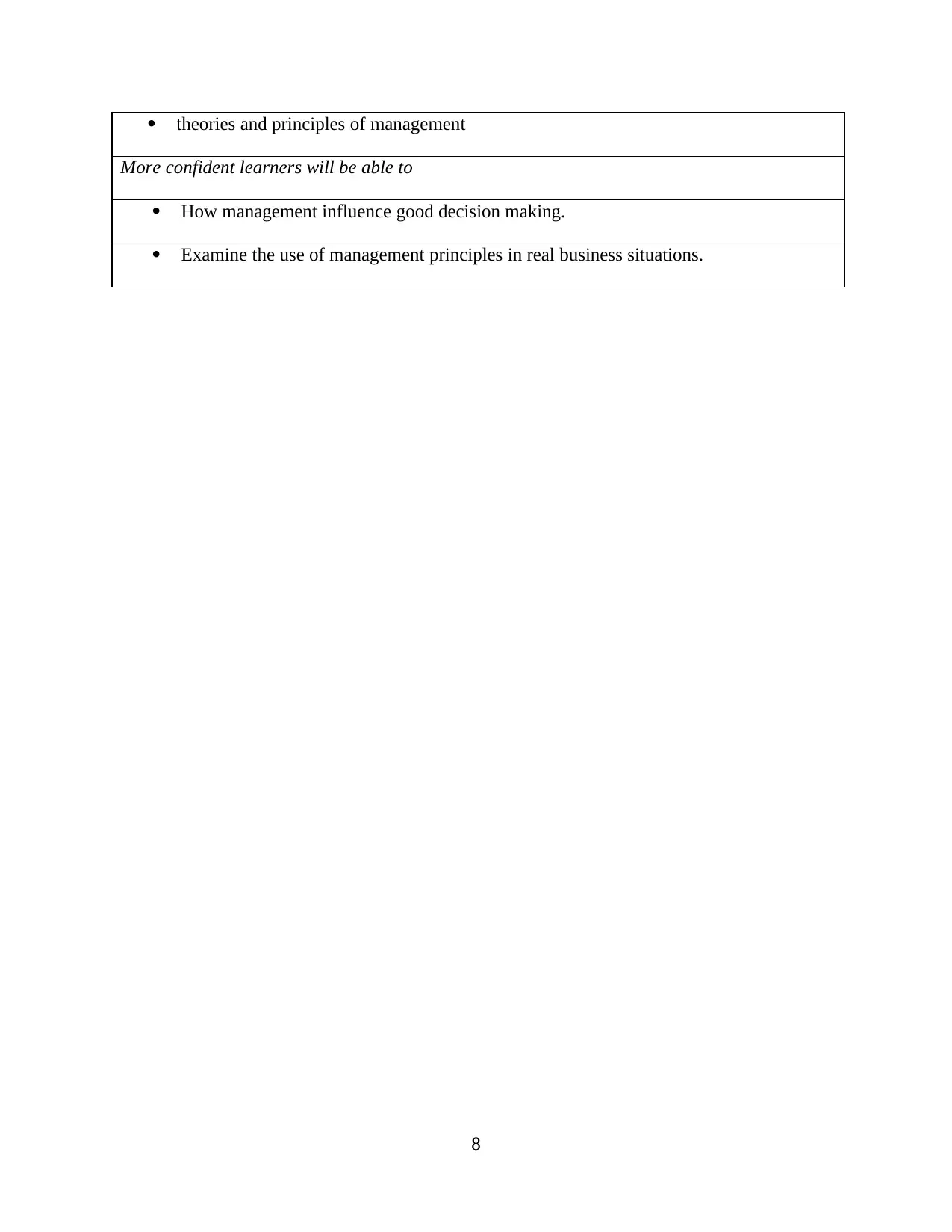
theories and principles of management
More confident learners will be able to
How management influence good decision making.
Examine the use of management principles in real business situations.
8
More confident learners will be able to
How management influence good decision making.
Examine the use of management principles in real business situations.
8
⊘ This is a preview!⊘
Do you want full access?
Subscribe today to unlock all pages.

Trusted by 1+ million students worldwide
1 out of 21
Related Documents
Your All-in-One AI-Powered Toolkit for Academic Success.
+13062052269
info@desklib.com
Available 24*7 on WhatsApp / Email
![[object Object]](/_next/static/media/star-bottom.7253800d.svg)
Unlock your academic potential
Copyright © 2020–2025 A2Z Services. All Rights Reserved. Developed and managed by ZUCOL.

